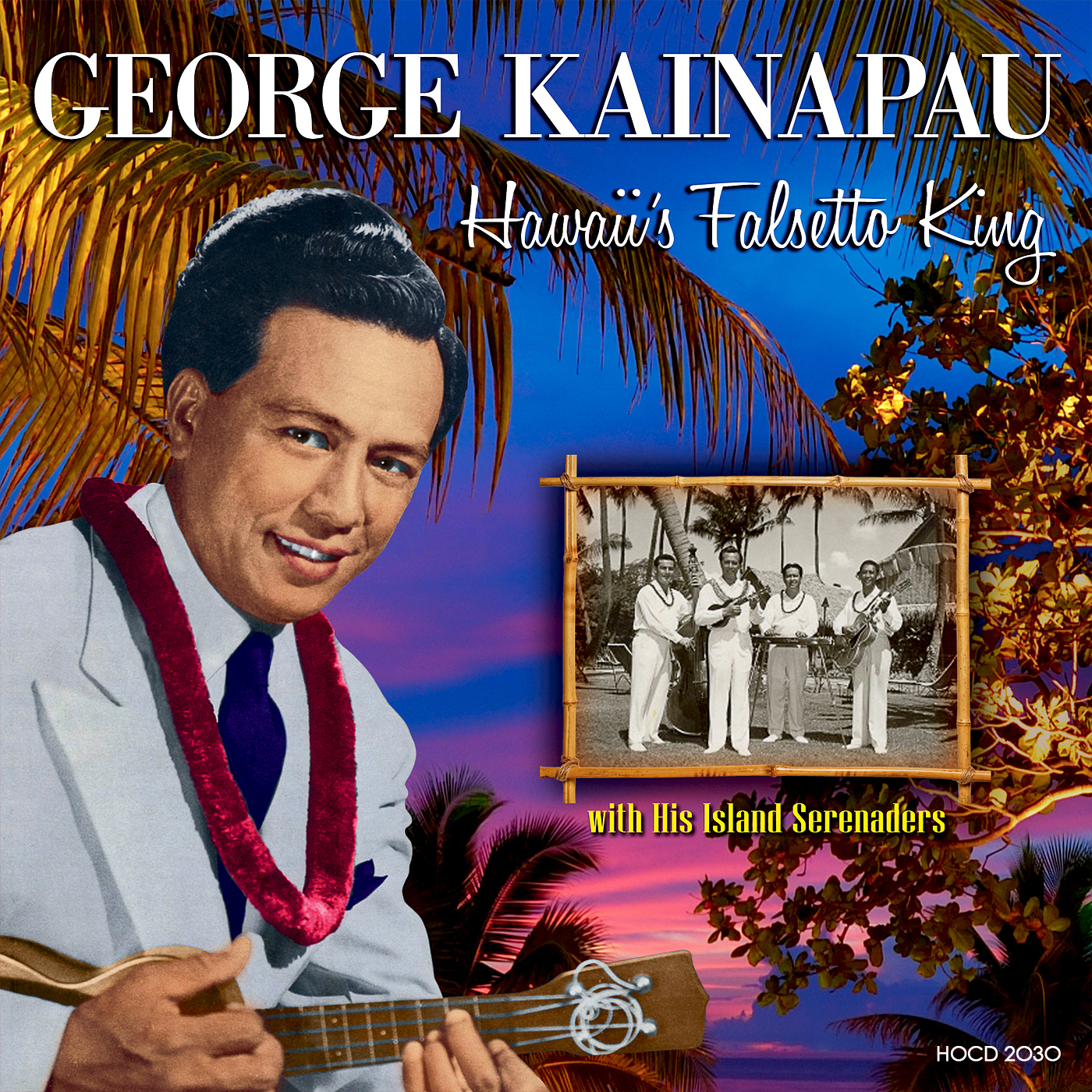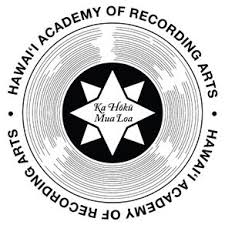On May 22, 1905, George Kainapau was born in Ola'a, Hawaii, nine miles from Hilo on the road to the Big Island’s Kilauea volcano. The Ola’a Sugar Company was expanding in 1905, taking over the Puna Sugar Company, and positioning Ola’a for rapid growth. Coffee trees and the native ohia forests were uprooted. A unique home-owning class of small farmers began to grow sugar cane for the Ola’a mill.
But George Kainapau was not destined to farm cane in Ola’a. The slender Hilo Union School student soon developed a spectacular Hawaiian male falsetto singing voice and began singing at the Volcano House in the 1920s.
In 1928, Sol Ho'opii, “Hawaii’s Steel Guitar King”, returned home from the mainland. Sol took George on a tour of the Hawaiian Islands. The pair then traveled to Hollywood, California, where George made his recording debut on January 18, 1929 for Columbia Records. At the age of 23, George Kainapau sang “Hilo Hanakahi” in front of Sol Ho'opii and Andy Iona.
George Kainapau’s star was rapidly rising. George would soon be a featured soloist for Lani McIntire & his Hawaiians, Ray Kinney and his Hawaiian Musical Ambassadors, and Danny Stewart and his Islanders, appearing in the finest hotels and clubs between Hollywood and Manhattan, throughout the 1930s.
After Kainapau had a sparkling diamond set in an upper front tooth, the falsetto extraordinaire exuded even more charisma on stage.
From 1941 to 1947, he returned home to become part of the Hawaii Calls radio programs in Waikiki. On January 21, 1947, George joined Al Kealoha Perry & his Singing Surfriders for their opening at the Royal Hawaiian Hotel.
On July 4, 1947 George opened at the Royal Hawaiian Hotel as part of the Royal Hawaiian Serenaders. The veteran harmony quartet consisted of Alvin Kaleolani Isaacs on guitar, Benny Kalama on bass, Tommy Castro on steel guitar, and George Kainapau on ukulele. George sang the high falsetto part of their four-part harmony arrangements.
George Kainapau spent the first half of the 1950s touring the mainland, but he was lured home to Hawaii by Henry J. Kaiser to play the Ale Ale Kai Room in the brand new Kaiser Hawaiian Village.
Henry J. Kaiser (Born: May 9, 1882; Sprout Brook, New York. Died: August 24, 1967: Honolulu, Hawaii) an American industrialist, “father of modern shipbuilding”, automobile manufacturer, and real estate developer has been described as "America's boldest, most spectacular entrepreneur."
In 1907, Henry Kaiser married Bessie Forburgh, daughter of a prosperous Virginia lumberman. After four decades of marriage, Bess Kaiser passed away on March 14, 1951. Less than four weeks later, on April 10, 1951, 69 year old Henry J. Kaiser surprised everyone by marrying 34 year old Alyce Chester, the chief nurse who had cared for Bess during her lengthy terminal illness.
Alyce (Ale) became the perfect hostess for the tycoon’s considerable VIP entertaining. In 1953 the Kaisers relocated from Oakland, California to Honolulu.
Henry J. Kaiser was disappointed with the shortage of hotel rooms in booming Waikiki, so the opportunistic leader of a vast industrial empire focused on underdeveloped land at Kalia.
Kalia was situated at the Ewa end of Waikiki, the furthest point from Diamond Head. Prior to Western contact, the area had been home to some of the most productive fishponds in the Hawaiian Islands. Ka’ihikapu and Paweo were the two largest ponds at Kalia. After contact, the Waikiki area gradually grew into a resort destination. The Ala Wai Canal was dug through the remaining wetlands of the former Hawaiian aquaculture system to reclaim the surrounding land and transform the environment of Waikiki. By 1928, the project was completed as the area adjoining Kalia was filled in.
The Pierpoint Hotel, Hummel’s Court, and Cressaty’s Court, all located at Kalia, were acquired by the Heen Investment Company in May of 1926. The six acres were re-landscaped, the cluster of cottages was renovated, and a new main building was added with the Tapa Room and a dance floor. The site, renamed Niumalu Hotel, meaning “sheltering palms”, opened in 1928.
In late 1954, Henry J. Kaiser and Fritz B. Burns purchased the 8 acre John Ena Estate, and an assemblage of adjoining properties from individual owners, including the Niumalu Hotel.
The Niumalu Hotel was completely revamped into the Kaiser Hawaiian Village Hotel by moving the ocean-side cottages back to the middle of the new property footprint and clumping them around a pair of new swimming pools. Fake roofs were added to the 24 cottages, and Samoan craftspeople from Laie, O’ahu, were brought in to apply thatch to those secondary roofs. The Tapa Room was positioned mid-property, later to become the showcase for Alfred Apaka.
The salt flat that bordered the ocean was transformed. A new Kaiser Channel was dredged through the ocean reef for the Ale Ale Kai catamaran fleet. A four-acre lagoon was excavated with the coral fill building the foundation for a new large beach. A tiny island was placed in the middle of the Kaiser Lagoon. Three thousand truckloads of sand were purchased from Kuhn Bros. Construction Co. in Manhattan Beach, California, hauled on railroad cars to San Pedro, and barged over to Honolulu Harbor to create a 150 foot wide beach over what had been jagged coral. The new beach was named for Duke Kahanamoku, the legendary Hawaiian swimming champion who was born and raised at Kalia.
The oceanfront was now clear to accommodate a tree-story hotel, entranceway shops, and a restaurant called the Ale Ale Kai Room.
The 18-acre Kaiser Hawaiian Village resort opened with a gala celebration on September 16, 1955. KHVH Radio, named for the Kaiser Hawaiian Village Hotel, continuously promoted the new hotel, its restaurants and entertainment.
Alyce “Ale” Kaiser was the inspiration for the open air Ale Ale Kai Room and the nearby Ale Ale Kai catamarans. Ale’s favorite color was a soft coral pink. But when the dyed leather arrived to upholster the restaurant’s furniture, it was bright hot pink. The Ale Ale Kai Room was opening just two days later, so the leather had to be used. The public became enthralled with “Kaiser Pink” and Henry J. made it his trademark. The hotel’s sheets, pillows, towels, napkins all turned pink. Even Kaiser’s catamarans, cement trucks, tractors, bulldozers, and cranes became pink.
George Kainapau and the Island Serenaders opened at the Ale Ale Kai Room at the Kaiser Hawaiian Village Hotel on August 1, 1956.
George Kainapau, 51, was featured on ukulele and falsetto vocals. His Island Serenaders consisted of Sonny Kamahele, 35, on guitar and vocals, Charlie “Kaipo” Miller, 27, on bass and vocals, and Jules Ah See, 32, on steel guitar.
The quartet performed twice nightly in the Ale Ale Kai Room: a cocktail hour show followed by a dinner show. At 11:00 PM, Sonny and Jules would join Benny Kalama and the Villlagemen for the Alfred Apaka show in the Tapa Room of the same hotel.
Solomon “Sonny” Kamahele, Jr. (08/28/1921 – 02/11/2004) served Hawaii as a distinguished and charming “Ambassador of Aloha”, both here and in Hollywood.
A headliner in Waikiki, a fixture on the Hawaii Calls radio show, and an entertainer who shared the stage with the likes of Alfred Apaka, Harry Owens, Danny Stewart, and Sam Koki, Sonny was a Hawaiian musician’s musician. His distinctive “Sonny stroke” guitar invigorated any arrangement. In 1996, the Hawaii Academy of Recording Arts recognized Solomon “Sonny” Kamahele, Jr. with the prestigious “Lifetime Achievement Award”.
Charles Kaipo Miller, Jr. (06/29/1929 – 08/15/1978) was born in the mainland USA, but tutored in Hawaiian music by his father, a gifted Hawaiian entertainer. Charlie had a rich tenor voice and excelled at both guitar and standup bass. Once he came to Hawaii, he was highly sought after for his musicianship and singing. He also performed on Hawaii Calls, and most of the major showrooms in Waikiki.
Jules Lee Ah See (06/19/1924 – 06/12/1960) was a consummate steel guitarist who was known for attacking his notes with uncanny precision. He is remembered for his precision playing, his definitive background fills, and his use of uncommon tuning for solo breaks. Jules had two Magnatone double 8 with three legs steel guitars. One was used indoors at the Tapa Room, while the other was used for outdoor gigs like the open air confines of the Ale Ale Kai Room.
J. Douglas Allen captured this Ale Ale Kai Room performance on one special evening in April of 1957. His wife, Toni, is saluted from the stage repeatedly by their friend, George Kainapau.
The Ale Ale Kai Room gig soon ended, as George Kainapau opened with Harry Owens at the Tropicana Hotel in Las Vegas in September of 1957, followed by a season at the El Mirador beginning on December 6, 1957. In 1958, George played at The Hawaiian in Long Beach, California. On July 17, 1959, he was featured in the “Salute to Hawaii” at the Hollywood Bowl, celebrating Hawaii becoming the 50th State.
Eventually, semi-retired, George settled with his wife Ruth in Kona, Hawaii. In the mid-1980s, they retired to California. George Kainapau passed away at the age of 87 on September 14, 1992 in Seal Beach, California.
George Kainapau is remembered as one of Hawaii’s greatest ever falsetto singers. Kainapau’s strong, controlled, and clear voice, void of any breathiness, could smoothly glide from the falsetto register to high tenor without any break, or upon command, could utilize the Hawaiian ha’i ornament just as easily.
His ability to sing in G above a middle C is sometimes referred to as a high falsetto.
His appearances in a string of Hollywood’s Hawaiian-themed films brought Hawaiian falsetto singing to the attention of a worldwide audience, spawning numerous falsetto singers outside of Hawaii.
|





.jpg)
.jpg)
.jpg)
.jpg)
.jpg)
.jpg)



